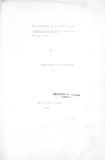| dc.description.abstract | In a set of experiments, both in the laboratory and in the
greenhouse, two varieties of finger miIlet (Enakura and EK-I)
were subjected to salinity of graded concentrations; namely
-I
the control, 4, 8 and 12 mnho cm ,Ec (as measured in a conductivity
bridge at 250Cl.
The laboratory experiments comprised the germination of
sterilized grain in paper-lined petridishes . The salt S-JI'8SS
effectively reduced rates and percentages of germination, the
root and shoot Ii~ear growth, and the final seedling dry weight.
The stress also delayed the peak a-amylase activity in the
seedlings. The comparison between the two varieties showed that
Ek-I had higher rates and percentages of germination, higher
Iinear growth, higher amylase activity and higher hydration levels
than Enakuru under alI experimental conditions.
The salt stress induced a significant loss of the cations;
sodium, potassium and calcium from the Seediness ,
The comparison between the effect of sail and that of solicitor
at equiosmotic concentrations show~d that in most aspects the
two solutes affected germination in a quantitative similar way.
The except ion was recorded for- lase activity
and the final seedling dry weight.
The greenhouse experiments comprised the culturinq of plants
in salinised soils. The soils were salinity seed by irrigation with
saline water prepared to the specification already mentioned above.
iii
Under the greenhouse conditions the salt stress effectively
reduced the rate of heading, the final plant height and grain yield.
Physiological processes such as the leaf carbon dioxide flux rates,
and transpiration were effectively reduced by the soiI salinity.
The leaf chlorophyll I content was also reduced by the salt stress,
but the tissue protein content was not.
So I salinity induced an increase in the tissue sodium content,
and a decrease in the tissue calcium concentration. But the stress
did not affect the potassium and chloride concentration in the tissues.
The soiI salinity lowered the soiI and leaf water potentials
in both varieties.
In most of the aspects studied it appeared that the salt
stress affected the plants primarily Iy via water stress-I ike processes.
Both varieties showed moderate degree of resistance to
salinity. The inter-varietal assessment showed that Ek-I had higher
potential resistance to salinity than Enakuru, even though the
latter variety had higher grain yield under the stress. It would
be expected that the results from the greenhouse experiment would
be very relevant for field trials because the conditions under
the open greenhouse systems could easily apply in the field.
The implications of the results from this set of experiments
are discussed in the light of the relevant literature. | en |

